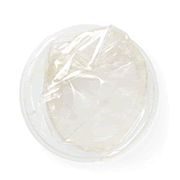It can definitely happen. Lube may be the answer here. Add a bit of your favorite lube to the internal condom and see if it gets any quieter.
Internal condom (FC2)

Want to learn more?
How do you remove a internal condom?
Removing an internal condom is pretty straightforward once you get the hang of it. To prevent pregnancy, you’ll twist the parts on the outside of your body closed like a baggie, so semen doesn’t spill out when you remove it. You might want to practice a few times before sex, so you are a pro when you need it.
Want to learn more?
Is the internal condom hard to insert?
Inserting an internal condom should get easier the more you do it. You might want to try practicing when it’s not the heat of the moment so you’re a pro when you need it.
Want to learn more?
Want to learn more?
How much does the internal condom cost?
You don’t need a prescription for the internal condom, but if you have health insurance—whether it’s through your parents, school, job, the Affordable Care Act (ACA) marketplace, or Medicaid—chances are good that you’ll be able to get internal condoms with no out-of-pocket cost with a prescription.
If you don’t have health insurance, it’s true that internal condoms are more expensive than other condoms, and since you have to use one every time you have sex, you’ll need to factor in how often you are having sex to figure out how much they’ll cost. If that isn’t an option for you, you can check with the health department in your area or your local family planning clinics and find out if they offer free or low cost internal condoms and other kinds of birth control (most do).
Want to learn more?
Is my partner supposed to feel the inner ring of the internal condom?
If your partner can feel the inner ring, you may not have it pushed far enough into your vagina. So try pushing it in a little farther.
Want to learn more?
If I'm allergic to latex, is there another birth control method that will protect me from STIs?
Yes, there is. Try using an internal condom. It’s latex free. Also, there are condoms available that are made out of polyurethane that you might want to check out.
Want to learn more?
How do you insert a internal condom?
Check out our section on how to insert an internal condom.
Want to learn more?
How common are STIs?
There are a few things you can do to protect yourself from STIs. First, get vaccinated for HPV and Hepatitis B, use condoms or internal condoms when you have sex, get tested regularly, use PrEP (and PEP) and talk openly about sexual health with your partner(s).
Super common. 1 in 2 people will get a sexually transmitted infection (STI) by the time they reach the age of 25.
There are a few things you can do to protect yourself from STIs. First, get vaccinated for HPV and Hepatitis B, use condoms or internal condoms when you have sex, get tested regularly, use PrEP (and PEP) and talk openly about sexual health with your partner(s).
Want to learn more?
I'm tired of using condoms, is there another birth control method that will also protect me from STIs?
Yes, try using an internal condom. It’s a barrier method that’s inserted into the vagina (or your butt with the internal ring removed) that will help protect against sexually transmitted infections (STIs). Just keep in mind, you can’t use an internal condom and a condom at the same time.
How effective are internal condoms at preventing pregnancy?
That all depends on how they’re used. With perfect use, that means using internal condoms correctly every time you have sex, they are around 95% effective, but the way they’re typically used you can expect them to be closer to 79% effective.
In other words:
For people who use the internal condom exactly as directed for a whole year, about 5 in 100 will get pregnant when they don’t want to during the first year they use this method.
For people who do not use the internal condom exactly as directed, about 21 in 100 will get pregnant when they don’t want to during the first year they use this method.
Want to learn more?

Heat up your weekends with our best sex tips and so much more.